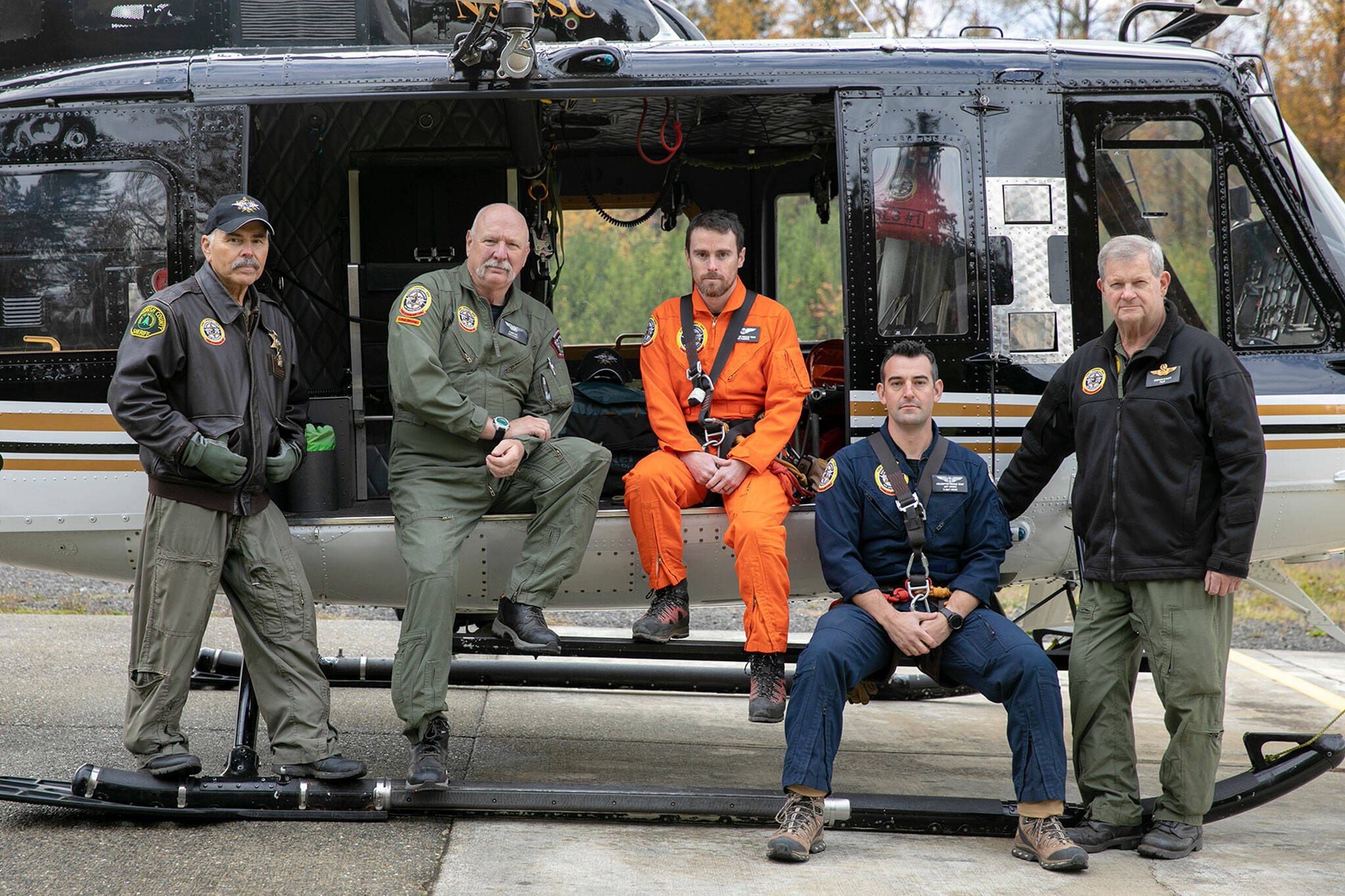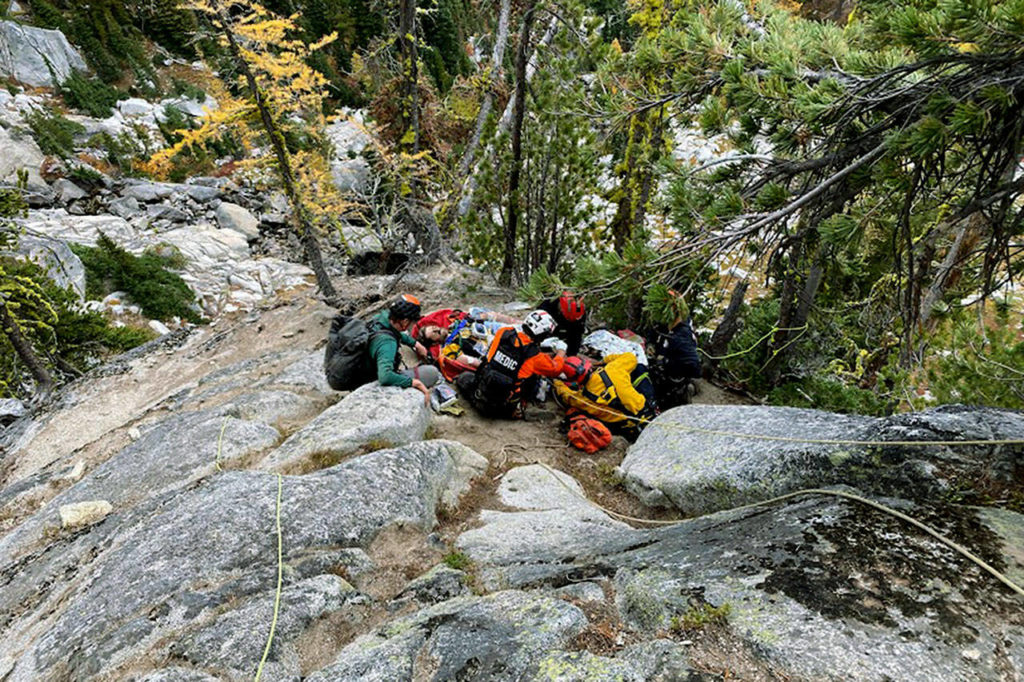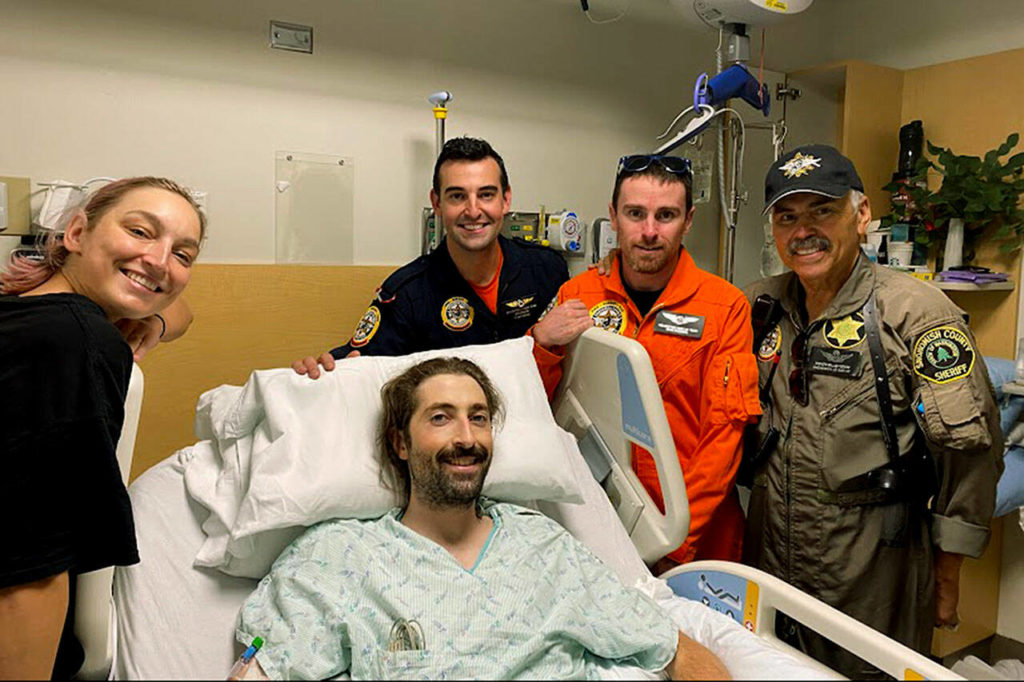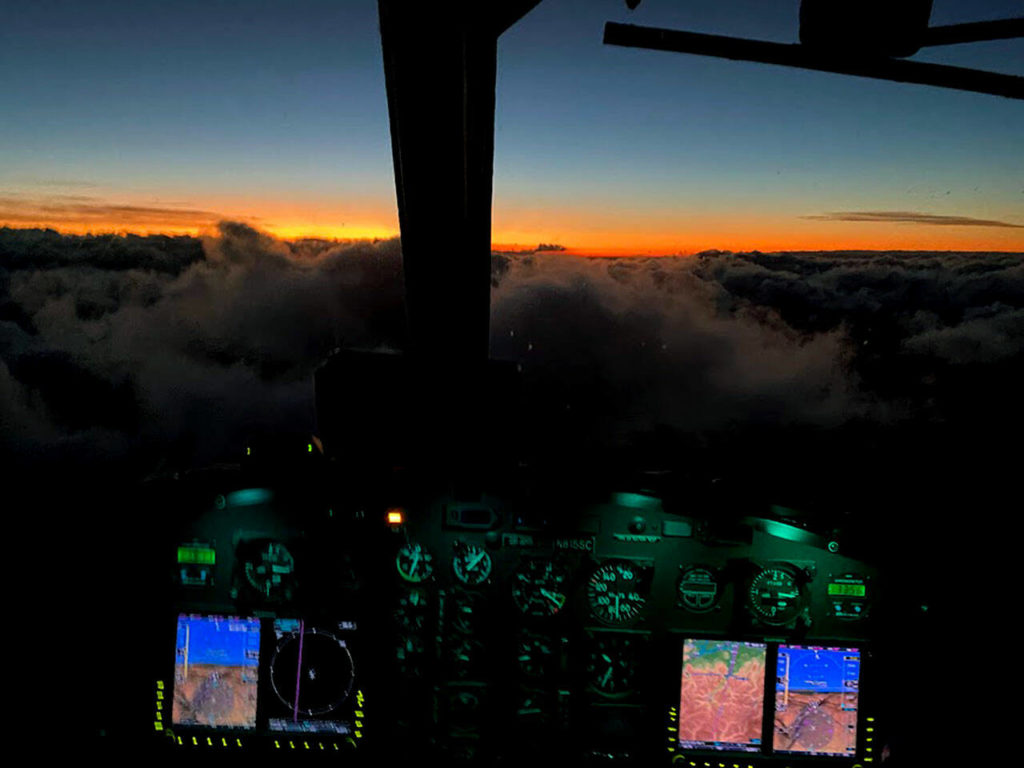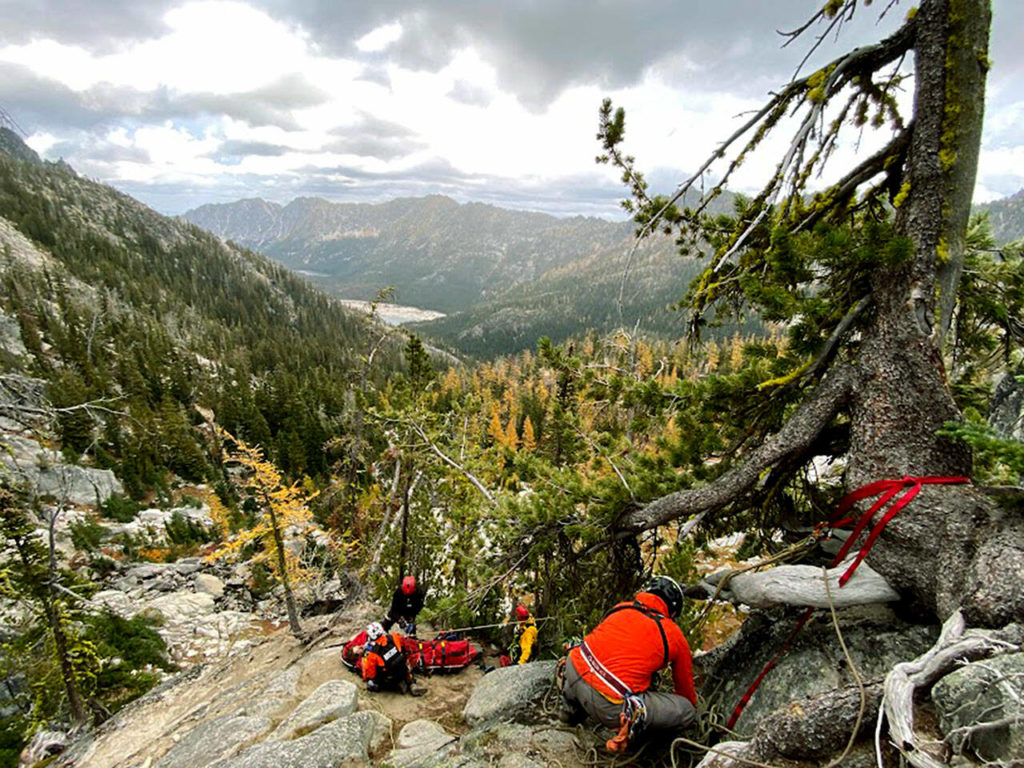LEAVENWORTH — Pinned beneath 4,000 pounds of granite, a hiker drifted in and out of consciousness on a jagged cliff face in the Enchantments.
Benedict Delahunty’s body was numb from the waist down. He couldn’t see his feet. A boulder had rolled onto his lap, trapping his legs and left arm.
It would be more than six hours before he was rescued.
What began as a day hike for Delahunty last month led to a search-and-rescue mission, life flight and a 2½-week hospital stay. After three surgeries and hours of physical therapy, doctors believe he will make a full recovery.
The hiker agreed to tell his story to The Daily Herald with the hope it will remind others to heed caution when exploring the outdoors. He wanted to shine light on the Snohomish County Helicopter Rescue Team and other first responder crews who saved his leg — and possibly his life.
“Treat even simple adventures or activities seriously,” Delahunty said. “Since I was doing something that seemed pretty easy and simple, I was less cautious at that time. You never know what’s going to happen. Always exercise the same level of caution, no matter what you’re doing.”
‘Whatever it takes’
Delahunty, 28, of Whitefish, Montana, had been visiting the west side to reconnect with his longtime friend Tristan Yerkes, of Seattle. He and Yerkes planned to hike the 18 miles through the Enchantments core zone — dappled with alpine lakes — in a single day, so Delahunty could fly home in time to make it to work the next day.
The pair met about 10 years ago in college on the East Coast.
“We were thick as thieves back then,” Yerkes said. “But over the years we lost touch.”
They reconnected this past summer at Delahunty’s wedding and planned the fall trip. Delahunty flew out from Big Sky Country, and Yerkes showed him around the Seattle area.
On Monday, Oct. 10, they arrived at the Colchuck Lake trailhead well before dawn broke, around 3 a.m.
“We considered running the trail,” Delahunty said. “But we decided to just hike it instead.”
The pair trekked up Aasgard Pass under an almost-full moon. They did not see anybody else on the trail.
As the sun rose, it illuminated sparkling cerulean lakes and smooth granite facades. Dragontail Peak towered overhead. Yellow larches speckled the mountainsides. Wildfire smoke obscured views of the Cascades in the distance.
About 10 miles in, the friends got off-route from the trail near Lake Viviane. They had been following rock cairns to find the trail, Yerkes said, that ended up leading to a toilet off-trail.
“We had a map,” Delahunty said. “And we decided to try and take a different route, which was just not the right decision.”
They started down steep uneven terrain, trying to rejoin the trail below. As Delahunty was descending, he grabbed a rock wall for support. It seemed stable. It was not.
A boulder shifted beneath him, then suddenly rolled. Delahunty tumbled down the cliff, and the massive slab of granite smashed onto his lap, trapping him.
He called for help. Yerkes turned back. Together, they tried to heave the boulder off Delahunty’s body.
“It was pretty much immediately clear that we couldn’t move it,” Delahunty said. “It was way too big.”
Yerkes called 911 and gave the dispatcher their coordinates. It was roughly 9:30 a.m. The pair, located 9 miles southwest of Leavenworth, could only wait. Yerkes talked to Delahunty, trying to keep him lucid.
“I was in a very uncomfortable position because I was pinned with my back against a rock wall,” Delahunty said. “I threw up a few times from the pain.”
Delahunty kept calm to the best of his abilities. He and Yerkes had both taken wilderness safety courses, he said, so they knew they needed to stay put and wait for professional help.
The boulder was shaped like a triangle. One point dug into Delahunty’s abdomen. He described the feeling as having to hold a sit-up for hours.
Yerkes took Delahunty’s vitals every 15 minutes.
“One of my favorite things about my friendship with Ben is our ability to spend time outside without constantly talking,” Yerkes said. “Quiet was not a luxury we could engage in because of that situation.”
‘Like an orchestra’
About 70 miles west, a helicopter rescue request rang out at Taylor’s Landing, the headquarters of Snohomish County Volunteer Search and Rescue.
A sheriff’s deputy walked into the hangar to tell chief pilot Bill Quistorf.
Authorities were asking for a helicopter with hoist capability to rescue a hiker who had been trapped under a “sofa-sized” boulder, Quistorf said, at 6,400 feet of altitude in the Enchantments.
Quistorf paged his on-call team. Within a half-hour, four men joined Quistorf at the hangar: flight medic Jeff Brown, crew chief hoist operator Randy Fay, rescue technician Ryan Fleming and pilot Steve Klett.
It would turn into one of their most complicated missions ever.
“Because of the unusual mission request … I don’t think we’ve ever had anybody trapped by a boulder, I was trying to think of what equipment we needed to bring,” Quistorf said. “Because once we leave the hanger and go to Chelan, we’re not going to have it at our fingertips.”
Among the gear packed by the crew was an airborne tactical extraction platform, a cargo net, mountain rigging equipment and medical supplies.
Quistorf and the crew took flight at 11:15 a.m. in the Huey, less than an hour after the initial rescue request. Thick plumes of smoke from the Bolt Creek wildfire obscured views across the North Cascades. Heavy wind turbulence made it hard to fly the chopper.
“I had to abort a few times before we got in there because of the wind direction,” Quistorf said. “I had to determine which way the winds were coming from because they were swirling around. The Enchantments is a large bowl up on the top of the mountains.”
As the helicopter got closer to the coordinates, Brown and Fleming were lowered down to a small ledge surrounded by trees. It was roughly 12:30 p.m. The pair radioed back to the chopper for more medical gear and rigging gear.
“The last thing we wanted,” Fleming said, “was another rock to fall or something. We really took our time and were patient to make sure the scene was safe.”
The crew used a tree above as an anchor to secure Delahunty, the volunteers and all the gear with ropes.
When the crew got closer, they realized the boulder was being held in place on top of him by another tree.
“If the pine tree gave way, because it’s on the edge of a cliff, the boulder could move,” Brown said. However, “Delahunty could get taken down the cliff as well.”
Brown said he trains for myriad scenarios as a medic, but the scene that day was particularly complex.
“From a patient standpoint,” the medic said, “we had a lot of concerns right off the bat — mostly the things we couldn’t see.”
Brown could not see Delahunty’s legs. He couldn’t tell if he was bleeding externally. Or internally, from broken bones. Was his pelvis shattered? His abdomen?
“He was in, I would say, fairly good spirits for being crushed by a boulder,” Brown said. “He was able to talk to us, answer all our questions.”
Delahunty’s blood pressure was low. The medic hooked him up to an IV.
Meanwhile, Fleming and other crew members grappled with how to extract Delahunty from under the stone. The helicopter rescue team did not have any heavy lifting equipment. So the Wenatchee Valley and Leavenworth fire departments flew in gear to a ridge above.
Pressure lift airbags were wedged under the boulder. Once inflated, Delahunty’s arm was freed.
But the clock was ticking.
Delahunty was in critical condition. The longer he stayed trapped, the worse his chance of survival became.
“When you compress tissue, especially big tissue like muscle, it starts to die,” Brown said. “As that tissue dies, it starts to leak and release toxins from those damaged cells.”
Brown said his biggest fear was that lifting the boulder all at once would allow all those built up toxins to rush back toward his central circulation, sending Delahunty into cardiac arrest. The medic prepared Delahunty for “the lift” by giving him medications to help control his blood pressure.
“It was kind of like an orchestra,” Brown said. “You know everything had to be played and put in place at the right time to make sure that us doing something good — like lifting the rock — wouldn’t then kill him.”
The medic rationed his limited medicine and IV fluid to keep Delahunty from crashing.
“We didn’t have any resupply,” Brown said.
All the while, Brown feared he would have to amputate Delahunty’s legs if they could not move the boulder fast enough.
The crew kept trying to carefully move the boulder with the airbags.
Delahunty drifted out of consciousness. He woke up about an hour later.
“When I came to, it seemed like they were at a point where they had tried so many different things and they were unsure of what would work,” he said. “I was hoping to just come to in the hospital, because I just didn’t want to deal with being conscious or being part of the situation anymore.”
Then something caused the boulder to shift suddenly, unexpectedly.
“We were quite concerned,” Brown said, “that it had crushed him more, that it had done more damage to his leg. He wasn’t able to tell us ‘yes’ or ‘no,’ because he wasn’t able to feel anything.”
After the crew lifted Delahunty from under the rock, they saw a 12-inch hole in his leg, behind his right knee. He had been bleeding for hours. Brown put a tourniquet on the wound and prepared Delahunty for a hoist extraction. They called for the helicopter.
‘Flying blind’
Right when the 120-foot hoist rope was lowered, the wind picked up.
“We got hit with some sudden downdrafts from the mountain, and I had to peel away and abort,” Quistorf said.
The helicopter flew to Leavenworth, without the patient.
It was time for plan B: The crew prepared Delahunty to be carried roughly 8 miles to the Snow Lakes trailhead. They wrapped him into a metal litter. It would take the crew at least eight hours to hike out.
Delahunty described the situation as “uncomfortable.”
“I was coming from being completely pinned by a boulder to then being wrapped in a stretcher,” he said. “I only had like two minutes of actual freedom where I could like move my body. Then it was right back to me being strapped down, in a claustrophobic situation.”
He had to mentally prepare himself to be stuck for hours longer as the crew carried him out.
“That’s not an easy hike on your feet,” Brown said. “Let alone, you’ve got six guys who are trying to carry 180 to 200 pounds of patient, plus gear, over technical terrain.”
About 45 minutes after the hike extraction began, Quistorf radioed in to the crew on the ground. The winds had calmed down. Quistorf would return and make one last-ditch effort to rescue Delahunty.
They lowered the hoist rope and the crew was able to grab hold. Brown climbed into the helicopter. Next, they hoisted Delahunty up hundreds of feet.
“Once I was hooked in and rising up to the helicopter, I was just so happy,” he said.
The crew’s plan was to fly Delahunty to Harborview Medical Center in Seattle, a Level 1 trauma center. But plans changed once again. There wasn’t enough fuel in the helicopter to fly over the mountains, cut through headwinds and make it to Seattle safely. So they took Delahunty to Wenatchee Valley Hospital.
Quistorf said in his 50 years as a pilot, this was in the top three most technical rescue missions.
“The wind had us flying blind,” he said. “Everyone had to be at the top of their game in order to pull this one off.”
The majority of the Snohomish County Helicopter Rescue Team’s missions in summer and fall of 2022 were in the Enchantments, Sgt. Greg Sanders said.
“It was kind of unusual this year, because our search-and-rescue missions seemed to be down,” he said. “But our helicopter missions have been up.”
One reason for that, Sanders said, is some neighboring counties don’t have a helicopter with hoisting capabilities, so they ask for help from Snohomish County crews.
Between July and October, the helicopter team responded to at least five calls in the Enchantments.
Hindsight is 20/20
At the hospital that night, doctors performed an emergency fasciotomy on Delahunty’s leg to relieve swelling and pressure.
He was taken by ambulance the next day to Harborview Medical Center. Doctors there did a skin graft and repaired broken bones with pins. His femur and tibial plateau were fractured. His body was riddled with blood clots. Delahunty lost more than 20 pounds during his 2½ weeks in the hospital. That was scary, he said, because he was already thin.
A week into his stay, members of the Snohomish County Helicopter Rescue Team paid Delahunty a visit. Other visitors — including Delahunty’s wife, Missy Westland, and hiking buddy Yerkes — also spent time there during the recovery.
One month has passed since Delahunty was released from the hospital. He is back home in Montana, where he is focused on physical therapy and getting back to work. His skin graft is fully healed. He swims in a pool to regain mobility.
“I’m incredibly grateful to Snohomish County Search and Rescue,” he said. “Four hours to assemble that many professionals is pretty impressive. I’m really lucky to be alive, to have my legs. Jeff Brown, all the volunteers, I can’t thank them enough. They’re heroes.”
Among the other agencies who responded were Cascade Ambulance, Chelan County Mountain Rescue, the Chelan County Sheriff’s Office, Wenatchee Valley Fire Department, Chelan County Emergency Management and Chelan County Fire District 3.
Initially, doctors thought it would take Delahunty at least six months for a full recovery. But the process has been quicker, Delahunty said. He thinks he’ll be healed before skiing season ends.
The first thing he plans to do when he’s fully recovered is go splitboarding. He also looks forward to being able to go for a walk with his dog through town or on a hike. The simple things.
Delahunty said he will be much more cautious with any type of outdoor recreation moving forward. When the flashbacks pop up in his mind, he quells them by thinking about future plans and staying positive. He reminds himself that hindsight is 20/20.
“I’m trying to view each step of the healing process as little milestones,” Delahunty said. “Every appointment I have, or like, getting stitches removed.”
The experience inspired Delahunty to join a local search-and-rescue volunteer crew in Montana.
“This really kind of showed that anything can happen,” he said.
Delahunty obviously did not finish the Enchantments thru-hike, but his hiking buddy did. Yerkes trekked out alongside a search-and-rescue crew, a trip that lasted well into the night.
“The whole time I was hiking out,” Yerkes said, “it was like, ‘Ben is going to lose his leg, Ben is going to lose his leg, it’s all my fault, it’s all my fault.’”
When Yerkes got back to the trailhead, he learned his friend would be OK. He said he was amazed at the search-and-rescue crews who got Delahunty out in one piece.
“Those actions are brave and heroic,” Yerkes said. “But it’s just what they do with their time or their work. They’re just there to be good people, because they know it’s a good thing to do.”
A silver lining was that the scare brought the two friends closer together. Yerkes said he has been checking in on Delahunty. The pair jokes they succeeded that day in their goal of reconnecting.
“When something like that happens to two people, it is an instant connection that you’ll share for the rest of your life,” he said.
If Delahunty makes a full recovery as expected, Yerkes hopes to make another attempt at the Enchantments hike alongside his friend.
“I’m going to harass him to come out here next year, same date, same time,” Yerkes said. “We’re going to finish it together.”
Ellen Dennis: 425-339-3486; edennis@heraldnet.com; Twitter: @reporterellen.
Talk to us
> Give us your news tips.
> Send us a letter to the editor.
> More Herald contact information.
